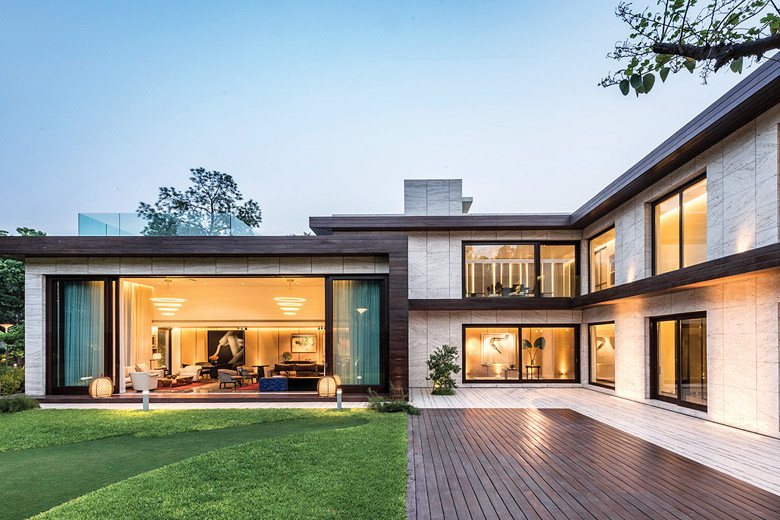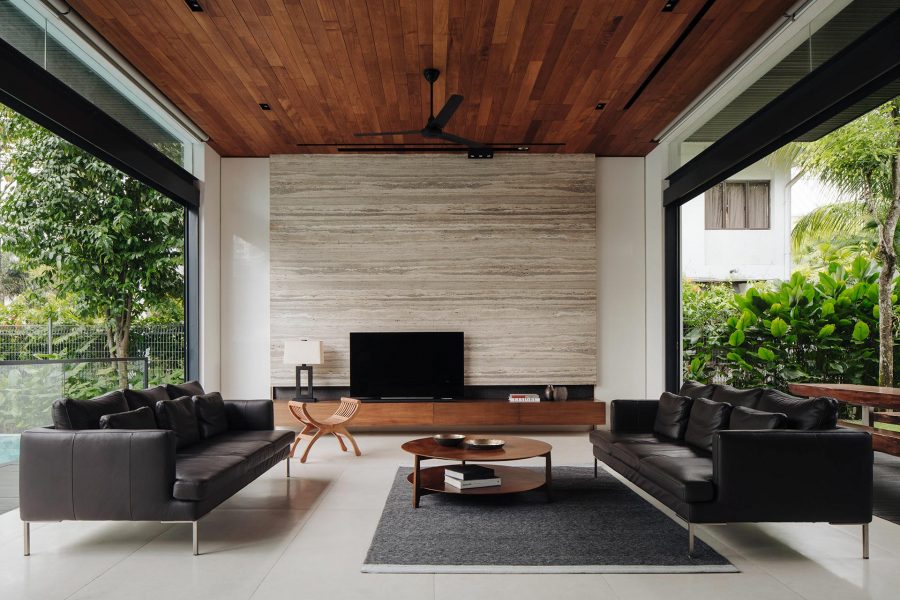
Top 10 Architectural Trends for Homes in India– The term architecture design has evolved dramatically in the last couple of decades. Architecture in India reflects the influence of the rulers who stamped our country at various times with their power. Trends are usually evolving societal needs. The top 10 Architectural trends for homes in India are all about embracing eco-conscious designs, adaptable spaces, and technologies.
The architects focused on redefining the landscape with trends that prioritize functionality, well-being, and environmental responsibility. Architects and designers are exploring all the areas where they can experiment, and adapt a wide range of new trends into their design solutions, which, in turn, would offer optimal efficiency and comfort to the residents.
Top interior designers in India and the world predict that people will shift to natural-friendly architectural designs. New trends include a bit of minimalism in nature-inspired interior design.
The architectural landscape of India is diverse and dynamic, with a rich blend of traditional ethos and contemporary sensibilities. The article aims to highlight the top 10 architectural trends for homes in India, with changing lifestyles, and convenience, yet good-looking options.

Emerging Home Architecture Trends Redrawing the Landscape of Urban India
The architecture scene in India has reached a level of change never seen before, especially in urban areas where the landscape is shifting dramatically in residential spaces. The population of the urban areas is increasing day by day, and urban land is becoming scarce. The vertical development, mixed-use buildings, and compacts are the popular house models that are taking center stage.
Smart Urban Planning & Vertical Living
The high-rise apartments in cities such as Mumbai, Delhi, & Bengaluru have green zones, rooftop gardens, and other sustainable features. The rainwater harvesting, solar, double-glazed windows, etc. are using smart design principles. These trends within the Indian housing market are indicators of how contemporary home architecture is transitioning into environmentally responsible and space-efficient methods.
Bringing Outdoor Spaces In
People spend more time at their homes after the pandemic. The demand for outdoor spaces in homes is becoming significant. Architects are designing private balconies, indoor courtyards, and terrace gardens to encourage a natural environment in homes. The modern houses have relaxation zones, yoga places, and small urban farms, which make for a healthier and more meaningful lifestyle.
Multi-Functional Rooms
The significant modern trend that is shaping Indian homes is versatility. Nowadays, people are doing remote work and online education, and more homeowners want multi-functional spaces. The living space room can be easily transformed into a living room, the bedroom into a reading area, and the dining area should have modular storage. This flexibility in design creates an impressive look for my home, and it is also practical in smaller living spaces.
Top 10 Trends of Architecture Design for Homes in India
3D Print Designs
The countless number of possibilities make 3D print design a hit. It advanced printing technologies helpful in creating meaningful and eye-catching designs, architects are taking a practical and simple but sustainable approach to building masterpieces. Moreover, this trend not only helps to reduce construction time and wastage but will also help to make the overall project cost-efficient.
Automation in Homes
This trend helps architects to bring enhanced convenience, security, and energy efficiency. Smart homes are not just luxury but are also about unparalleled functionality. Additionally, efficiency and sustainability are bases for incorporating smart buildings and automation into the trends. It provides remote-access features to manage various home functions, offering the residents a seamless and sophisticated living experience.
Ambient Lighting
People’s preferences for natural lighting are shifting, it reduces energy costs significantly. Natural light also gives the room a larger, airier appearance. In addition, sunlight is a fantastic source of vitamins, which may eventually cause chronic diseases. While lowering the need for natural gas and keeping the space warm.
Landscape Palettes
Humans are always in affairs with soothing grays, greens, and earth tones, due to aesthetic preferences. Science has proven a correlation between mental health and beauty in both natural and designed spaces, and it has infiltrated architectural trends. Moreover, natural color schemes and organic ones found in nature reduce stress, lower blood pressure, and heart rate, and increase productivity and creativity.
Bold Patterns
The bold patterns allow you to impart drama to any space. Patterned flooring, stone inlays, wall panels, and wallpapers offer a more permanent option for introducing patterns onto your interiors. And of course, accessories like striped or checked photo frames, floral patterned vases, dinnerware, etc. are also simple, go-to options. Bold Patterns bring an invigorating boost of energy into the home.
Nature Inspired Decor
The latest architectural design trends confirm the continued allegiance to nature and its ways. The imprints of nature will be seen in the inspiration of design, the form of furniture and textures ruling the interior scene. Architect design encompasses the influence of nature leading to a blissful inspiration. Natural materials and textures add unique calming character to spaces, and greenery that brings an abundance of freshness and cheer into the interiors.
Sustainable Architecture
In a world increasingly concerned about environmental impact, sustainable architecture is at the forefront of India’s design trends. Architects are embracing eco-friendly materials, energy-efficient designs, and green building practices to create structures that harmonize with the environment.
Cultural Expression
Architects are incorporating cultural elements from different regions of India into their designs. Whether it is from any corner of India, trends celebrate India’s diversity. True to its name, the heritage style is a fusion of luxury and contemporary. Rustic designs in an amalgamation of urban and rural effects often work wonders. The inclusion of antique artefacts and colonial-style furniture, as well as borrowing influences from other countries and cultures, is an offshoot of this trend.
Large Windows
Large windows are quite an architectural hit. There is no denying how they open up to natural light, elevating energy levels easily. When designed accurately and located at correct angles, large windows enable passive solar gain during the colder months. The larger the windows, the better the outdoor view.
Open Space
Open spaces have always been a trend in architectural interiors. People are choosing to stay connected and interact in open spaces with family or friends. It includes open kitchens, sitting rooms extending into dinner areas, or even suite openings. These multifunctional designs not only benefit everyday living but also add depth to small spaces.
Conclusion
The aforementioned top 10 architectural trends in India have contributed to the changing skyline of India but also set benchmarks for sustainable and responsible design practices. Design De Maison, in context, numerous architectural firms have emerged as a unique identity. Their work evolves the architectural narrative of the country and reflects a blend of aesthetic elegance, functional efficiency, and sustainability.
Frequently Asked Questions (FAQS) regarding the top 10 architectural trends in India
1)How can I get in touch with an Architecture company for potential projects?
The best way to contact architecture firms for potential projects is through their official websites. Most firms have contact forms or provide email addresses for business inquiries.
2)What is the biggest challenge that architecture is facing nowadays?
Undoubtedly, one of the greatest challenges modern architects face is environmental sustainability with climate change. Architects must create green buildings to minimize carbon footprints and reduce environmental impacts.
3) Which style of architecture influenced India?
Indo-Islamic architecture influenced the Rajput and Sikh styles as well. European styles including Neoclassical, Gothic Revival, and Baroque became prevalent across India.
4) What are the appropriate procedures or ways to contact an architecture firm for possible procurement of future projects?
The best way to contact an architecture company is to visit their website. Most have contact forms, email options, and consultation bookings. However, you can contact Design De Maison by visit https://www.designdemaison.in/ and call +917696551777.
5) What is the biggest challenge that architecture is facing today?
Environmental sustainability is an ongoing challenge. Architects are always working towards shrinking their carbon footprint and making the buildings they design more sustainable.
6) What architectural style contributed to India?
India has been affected by Indo-Islamic, Rajput, Sikh, and European (Gothic, Neoclassical, and Baroque) architecture.
7) Are smart homes cheap in India?
Yes, many smart home solutions are scalable and can be tailored to a moderate budget today, allowing for a larger segment of the population to enter it.





 Home
Home Portfolio
Portfolio Call Us
Call Us
 Whatsapp
Whatsapp Contact Us
Contact Us Call Us
Call Us Whatsapp
Whatsapp